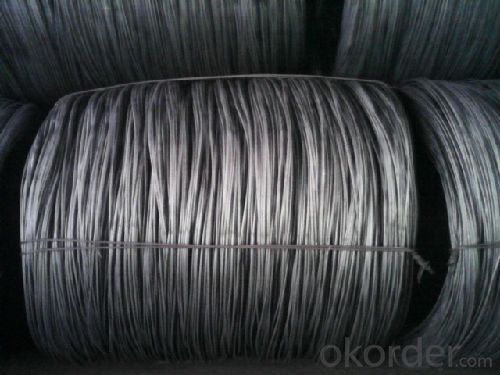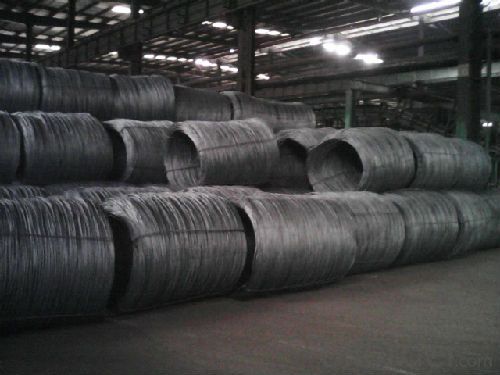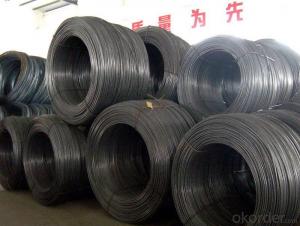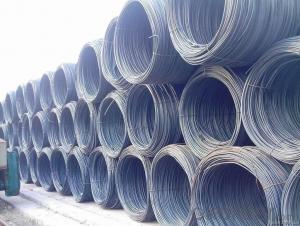Wire Rod High Qulity Hot Rolled Sae 1008b 5.5mmin Coils
- Loading Port:
- Tianjin
- Payment Terms:
- TT or LC
- Min Order Qty:
- 25 m.t.
- Supply Capability:
- 20000 m.t./month
OKorder Service Pledge
OKorder Financial Service
You Might Also Like
Product Description:
OKorder is offering Wire Rod High Qulity Hot Rolled Sae 1008b 5.5mmin Coils at great prices with worldwide shipping. Our supplier is a world-class manufacturer of steel, with our products utilized the world over. OKorder annually supplies products to European, North American and Asian markets. We provide quotations within 24 hours of receiving an inquiry and guarantee competitive prices.
Product Applications:
Wire Rod High Qulity Hot Rolled Sae 1008b 5.5mmin Coils are ideal for structural applications and are widely used in the construction of buildings and bridges, and the manufacturing, petrochemical, and transportation industries.
Product Advantages:
OKorder's Wire Rod High Qulity Hot Rolled Sae 1008b 5.5mmin Coils are durable, strong, and resist corrosion.
Main Product Features:
· Premium quality
· Prompt delivery & seaworthy packing (30 days after receiving deposit)
· Corrosion resistance
· Can be recycled and reused
· Mill test certification
· Professional Service
· Competitive pricing
Product Specifications:
hot rolled sae 1008b wire rod
1 .high quality
2. prompt delivery date
3. competive price and full size
| Product | wire rod |
| Standard | AISI,ASTM,BS,DIN,JIS,GB |
| Grade | Q195,Q235,SAE1006,SAE1008,SAE1018B,H08A,30MnSi,62B-82B |
| Diameter | 5.5mm-14mm |
| Coils weight | around 2 tons |
| MOQ | 100 Metric Ton,also depending on production schedule |
| Delivery Time | 25-45 Days |
| Packing | Standard export packing or as you required |
| Payment term | T/T, L/C |
| Application | construction |
FAQ:
Q1: Why buy Materials & Equipment from OKorder.com?
A1: All products offered byOKorder.com are carefully selected from China's most reliable manufacturing enterprises. Through its ISO certifications, OKorder.com adheres to the highest standards and a commitment to supply chain safety and customer satisfaction.
Q2: How do we guarantee the quality of our products?
A2: We have established an advanced quality management system which conducts strict quality tests at every step, from raw materials to the final product. At the same time, we provide extensive follow-up service assurances as required.
Q3: How soon can we receive the product after purchase?
A3: Within three days of placing an order, we will begin production. The specific shipping date is dependent upon international and government factors, but is typically 7 to 10 workdays.
Q4: What makes stainless steel stainless?
A4: Stainless steel must contain at least 10.5 % chromium. It is this element that reacts with the oxygen in the air to form a complex chrome-oxide surface layer that is invisible but strong enough to prevent further oxygen from "staining" (rusting) the surface. Higher levels of chromium and the addition of other alloying elements such as nickel and molybdenum enhance this surface layer and improve the corrosion resistance of the stainless material.
Q5: Can stainless steel rust?
A5: Stainless does not "rust" as you think of regular steel rusting with a red oxide on the surface that flakes off. If you see red rust it is probably due to some iron particles that have contaminated the surface of the stainless steel and it is these iron particles that are rusting. Look at the source of the rusting and see if you can remove it from the surface.
Images:



- Q:What are the different heat treatment processes for steel wire rod?
- There are several heat treatment processes for steel wire rod, including annealing, quenching, tempering, and normalizing. Each process has its own purpose and benefits. Annealing is used to soften the wire rod and improve its ductility. Quenching involves rapidly cooling the wire rod to harden it and increase its strength. Tempering is a process where the wire rod is reheated after quenching to reduce brittleness and improve toughness. Normalizing is similar to annealing, but it involves cooling the wire rod in still air to achieve a more uniform structure. These heat treatment processes can be used individually or in combination to achieve specific properties and characteristics desired for the wire rod.
- Q:What are the different types of steel wire rod surface defects that can occur during wire drawing?
- During the wire drawing process, steel wire rods may experience a range of surface defects that can have adverse effects on the wire's quality and performance. These defects, which can be caused by different factors, include: 1. Scale: Arising from the hot rolling or annealing processes, scale refers to a thin layer of oxide that forms on the wire rod's surface. It manifests as a dark, flaky coating and can negatively affect the wire's ductility and adhesion. 2. Scratches: Wire rods can acquire visible lines or marks, known as scratches, during handling, transportation, or wire drawing. These scratches compromise the wire's strength and may lead to failure when subjected to stress. 3. Slivers: Small, elongated metal flakes, called slivers, can embed themselves on the wire rod's surface. They can originate from inadequate cleaning of production equipment or defects in the steel manufacturing process. Slivers pose risks such as wire breakage or surface roughness. 4. Scale pits: Depressions or cavities, referred to as scale pits, can form on the wire rod's surface due to the presence of scale or impurities during drawing. If sufficiently deep, scale pits can affect the wire's appearance and mechanical properties. 5. Decarburization: Decarburization occurs when the carbon content on the wire rod's surface diminishes, resulting in reduced strength and hardness. This phenomenon is commonly observed during high-temperature operations like annealing, and it manifests as a lighter or duller color compared to the wire's core. 6. Corrosion: Wire rods can undergo corrosion when exposed to moisture, chemicals, or other environmental factors. This corrosion can cause pitting, rusting, or discoloration on the wire's surface, adversely affecting both its appearance and mechanical properties. 7. Lamination: Lamination defects manifest as thin layers or flakes that detach from the wire's surface. They can arise from flaws in the steel manufacturing process or insufficient bonding between layers during wire drawing. Lamination defects significantly compromise the wire's strength and ductility. To ensure the production of high-quality wire products, manufacturers employ diverse techniques, such as surface cleaning, inspection, and quality control measures, to identify and minimize these surface defects during the wire drawing process.
- Q:How is steel wire rod different from other types of steel products?
- Steel wire rod is different from other types of steel products because it is a semi-finished product that is primarily used for further processing into various steel wire and steel wire products. Unlike other steel products, such as bars or sheets, steel wire rod is typically hot-rolled and has a round cross-section. Its specific composition and mechanical properties are tailored to meet the requirements of wire drawing, making it suitable for manufacturing a wide range of wire-based products, such as nails, wires, cables, springs, and reinforcement materials.
- Q:What are the growth opportunities in the steel wire rod market?
- The growth opportunities in the steel wire rod market include increased infrastructure development, growing construction industry, and expanding automotive and transportation sectors. Additionally, the rising demand for steel wire rod in electrical and electronics applications, such as power transmission and telecommunications, presents further growth prospects. Furthermore, the trend towards lightweight materials in various industries, such as aerospace, is also expected to drive the demand for steel wire rod.
- Q:How is steel wire rod used in the production of tire reinforcement materials for vehicles?
- Steel wire rod is commonly used in the production of tire reinforcement materials for vehicles due to its high tensile strength and durability. The wire rod is typically formed into individual wires, which are then woven or wrapped into a mesh-like structure known as tire cord. This tire cord is embedded into the rubber compound during the tire manufacturing process, providing the necessary strength and stability to the tire. The steel wire rod ensures that the tire can withstand the forces and stresses encountered during vehicle operation, improving overall tire performance and longevity.
- Q:What are the main factors influencing the choice of steel wire rod order customer feedback process?
- Several key considerations can influence the choice of the customer feedback process for steel wire rod orders. The quality of the steel wire rod is a primary determining factor. If the product is of high quality and meets the customer's expectations, the feedback process is likely to be straightforward and positive. Conversely, if there are quality issues such as defects or inconsistencies, the feedback process may become more complex and require in-depth analysis. Another factor is the level of customer satisfaction with the overall buying experience. This encompasses factors like the ordering process's ease, the timeliness of delivery, and the level of customer service provided. A positive buying experience increases the likelihood of customers providing feedback and sharing their thoughts on the product. The supplier's reputation and track record also impact the customer feedback process. If the supplier has a history of delivering high-quality products and excellent customer service, customers are more inclined to give positive feedback. However, a supplier with a poor reputation or a track record of subpar products may receive negative feedback or no feedback at all. The importance of the steel wire rod to the customer's business is another consideration. If the rod is a critical component of the customer's operations, they are more likely to provide feedback and express any concerns or issues. Conversely, if the rod is not crucial, the customer may be less motivated to provide feedback. In conclusion, the choice of the customer feedback process for steel wire rod orders is influenced by factors such as product quality, customer satisfaction with the buying experience, supplier reputation, and the rod's importance to the customer's business. By considering these factors, suppliers can customize their feedback processes to effectively address customer concerns and improve satisfaction.
- Q:What are the different surface cleaning methods for steel wire rod?
- There are several surface cleaning methods that can be used for steel wire rods. These methods are designed to remove any impurities or contaminants on the surface of the wire, ensuring its cleanliness and enhancing its quality. Some of the different surface cleaning methods for steel wire rods include: 1. Mechanical cleaning: This method involves the use of mechanical abrasion to remove surface impurities. It can be done through processes such as wire brushing, sanding, or shot blasting. Mechanical cleaning is effective in removing rust, scale, or other loose particles from the surface of the wire rod. 2. Chemical cleaning: Chemical cleaning methods use various chemicals to dissolve or react with contaminants on the wire rod's surface. Acid pickling is a common chemical cleaning method used for steel wire rods, where the wire is immersed in an acid solution to remove oxide layers, scale, or other impurities. Alkaline cleaning is another option, which uses alkaline solutions to remove organic contaminants. 3. Electrochemical cleaning: This method involves the use of an electrical current to remove impurities from the wire rod's surface. Electrochemical cleaning processes, such as electrochemical pickling or electrocleaning, use an electrolyte solution and an electric current to dissolve or dislodge contaminants. This method is often used for stainless steel wire rods to maintain their corrosion resistance. 4. Ultrasonic cleaning: Ultrasonic cleaning utilizes high-frequency sound waves to create microscopic bubbles in a cleaning solution. These bubbles, known as cavitation, implode on the surface of the wire rod, effectively removing contaminants. Ultrasonic cleaning is particularly effective in removing oils, greases, or other organic substances from the wire rod's surface. 5. Steam cleaning: Steam cleaning involves the use of high-pressure steam to clean the surface of the wire rod. The steam's heat and pressure help to dislodge and remove contaminants. This method is often used for wire rods that are heavily contaminated with oils, greases, or other sticky substances. It is important to note that the choice of surface cleaning method for steel wire rods depends on factors such as the type and severity of contamination, the desired level of cleanliness, and the specific requirements of the wire's end application. Each cleaning method has its own advantages and limitations, and it is crucial to select the most appropriate method to ensure the highest quality and performance of the steel wire rod.
- Q:What are the common applications of oil quenched and tempered steel wire rod?
- Oil quenched and tempered steel wire rod is commonly used in various applications where high strength and durability are required. Some of the common applications include manufacturing of automotive parts, construction materials, industrial machinery, and tools. The oil quenching and tempering process enhances the mechanical properties of the steel wire rod, making it suitable for demanding applications that require resistance to wear, impact, and fatigue.
- Q:How is steel wire rod used in the manufacturing of staples?
- Steel wire rod is commonly used in the manufacturing of staples due to its strength and durability. It is first drawn into the desired diameter and then cut into appropriate lengths for staple production. The wire rod is then shaped into U-shaped or flat formations, creating the basic structure of the staple. These staples are then further processed, including processes like galvanizing or coating, to enhance their corrosion resistance. Overall, steel wire rod serves as a fundamental material in staple manufacturing, providing the necessary strength and structure for these widely used fasteners.
- Q:How is steel wire rod used in the production of wire rods for reinforcement?
- Steel wire rod is the primary material used in the production of wire rods for reinforcement. Wire rods are essentially long, cylindrical metal rods that are used to reinforce various structures such as buildings, bridges, and highways. The steel wire rod is first processed through a series of steps to ensure its quality and suitability for reinforcement purposes. These steps include heating the steel rod to a specific temperature, then rapidly cooling it to improve its strength and flexibility. This process is known as quenching and tempering. Once the steel wire rod has been properly processed, it is then fed into a wire drawing machine. This machine pulls the rod through a series of dies, gradually reducing its diameter and increasing its length. This results in a wire rod that is thinner and longer than the original steel rod. The wire rod is then further processed to achieve the desired properties for reinforcement purposes. It may be subjected to additional heat treatments to improve its strength and ductility. It can also be coated with various materials such as zinc or epoxy to enhance its corrosion resistance. After these processing steps, the wire rod is now ready to be used as reinforcement in various construction applications. It is typically cut into shorter lengths and shaped according to the specific requirements of the structure being reinforced. These wire rods are then embedded into concrete or other materials, providing additional strength and stability to the structure. In summary, steel wire rod is a crucial material in the production of wire rods for reinforcement. It undergoes a series of processing steps to enhance its properties, and it is then shaped and embedded into structures to provide strength and durability.
1. Manufacturer Overview |
|
|---|---|
| Location | |
| Year Established | |
| Annual Output Value | |
| Main Markets | |
| Company Certifications | |
2. Manufacturer Certificates |
|
|---|---|
| a) Certification Name | |
| Range | |
| Reference | |
| Validity Period | |
3. Manufacturer Capability |
|
|---|---|
| a)Trade Capacity | |
| Nearest Port | |
| Export Percentage | |
| No.of Employees in Trade Department | |
| Language Spoken: | |
| b)Factory Information | |
| Factory Size: | |
| No. of Production Lines | |
| Contract Manufacturing | |
| Product Price Range | |
Send your message to us
Wire Rod High Qulity Hot Rolled Sae 1008b 5.5mmin Coils
- Loading Port:
- Tianjin
- Payment Terms:
- TT or LC
- Min Order Qty:
- 25 m.t.
- Supply Capability:
- 20000 m.t./month
OKorder Service Pledge
OKorder Financial Service
Similar products
New products
Hot products
Hot Searches
Related keywords



























